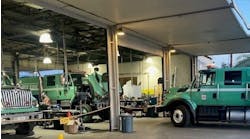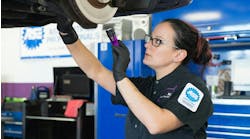Even in the worst of times, the trucking sector is asked to be at its best: maximum uptime and minimal delays. No excuses; just results. Because you know how it is. Low margins. Competition. Customer expectations. Economy hangs in balance. The usual.
I imagine in an alien invasion when the rest of the world would be in hiding, over-the-road trucks will probably still be braving the nation’s highways to resupply the resistance (or to offer tribute to our wonderful new alien overlords, who I for one, welcome). Meanwhile, work trucks will be out in force clearing the streets of rubble and patching up laser-scorched infrastructure.
Read more: How predictive maintenance can save fleets a fortuneSure, that may seem improbable, but during the chaos of the last three COVID-tainted years, order—and you could argue society itself—was maintained by the commercial vehicle operations who delivered vital goods and ensured the power stayed on. These few worked overtime while many were subsidized by the government to work less or not at all.
It was exhausting, especially considering the majority of drivers are far from spring chickens. The average age of drivers has hovered around the high 40s for many years. According to Lindsey Trent, co-founder and president of NextGen Trucking, it’s now 54 years old, while new entrants are 35.
Meanwhile, in the shop, it’s hard to keep young technicians. George Arrants, VP of ASE Education Foundation, is always quick to remind whoever will listen that two out of five automotive/diesel technicians leave the trade within two years. (He explains the problem in-depth here.) That means the exhaustive search to replenish the shop workforce never ends, a tiresome effort for all involved, from the managers in charge of onboarding to the experienced techs expected to train and mentor them.
A healthy society needs these two sides of the commercial vehicle sector lively and strong to function. So, what happens if the grim forecasts are true? Aliens don’t seem so bad compared to barren grocery stores and routine power outages, which is what is at stake.
The American Trucking Associations estimated the driver shortage—at about 80,000 or so now—will increase to 160,000 by 2030. The maintenance side is assumed to have an equal current deficit of techs, and the U.S. Bureau of Labor Statistics calculated the industry will add 28,100 “diesel service technicians and mechanics” each year over the decade.
Read more: A recovering workaholic's guide to self-maintenance
It’s worth noting that the world changes so fast and the moving parts are so complex that these specific numbers are likely off. (Remember, we have been told several times in the last 50 years that we had 12 years to change our behavior or Mother Nature would spank us back to the Stone Age.) But even if you don’t look at the data, put your ear to the shop floor and listen. You’ll hear the clamor of managers shouting in unison: “We can’t find good people to work for us!”
That’s what I hear on the regular, anyhow. And it’s a not-so-subtle warning sign of a systemic problem.
This issue may become exacerbated as fleets hold on to trucks longer. A recent Noregon Research report, “Unpacking the Commercial Vehicle Diagnostics Market: 2023” indicated in the U.S. and Canada, around a quarter of Class 8 trucks are under seven years old, one-third are between 8 and 15, and 40% are 15 or older. The total population in 2023 is expected to be 2.3 million. That’s a lot of trucks to maintain, and if the industry is short on technicians, fleets will wait longer to get trucks back on the road again.
In a story on trucking's Fountain of Youth, we reported the average truck age is 8.7 years, and after 500,000 miles, more maintenance issue crop up requiring more attention. There are some excellent tips in that piece from several very capable sources to provide guidance in that department.
The good news is troubleshooting broken systems—and fixing systemic problems in general—is kind of maintenance professionals’ thing, and root cause analysis is gaining traction industry-wide, which we dig into here. I advise fleets and their service partners to extend that holistic approach of maintaining individual systems to the overall maintenance ecosystem. In the longterm, this would require more training and determination expended from both shops and fleets, but less energy over time. This is all the more crucial as the industry may have less bodies available.
A fresh approach should also recharge workers’ batteries and rejuvenate the entire operation. To get there, first you’ll need to examine what your biggest pain points are.
If the shop is always getting maintenance surprises when trucks get to the terminal, encourage drivers to get more thorough on pre-trips and driver vehicle inspection reports (DVIRs). They are the first and best line of defense to catch small problems before they grow into time-consuming ones. Maybe derates have become an epidemic, so kick the tires on one of the myriad remote diagnostic and telematics solutions out there. These can give maintenance teams advance warning on serious issues. And if you uncover the root cause of one truck’s infection, you could apply that to similar models across your fleet.
And if certain parts are always on backorder, requiring shifting of assets or turning down loads or jobs, it’s high time to find a backup supplier or new distributor partner. All it might take is a detailed chat with your current parts distributors so they know what you need and how they can serve you better. Click here for more.
Just look at this moment as the perfect opportunity to perform some managerial spring cleaning with one goal in mind: How you can stop treating the symptoms of shop inefficiencies and seek out the true cause.




